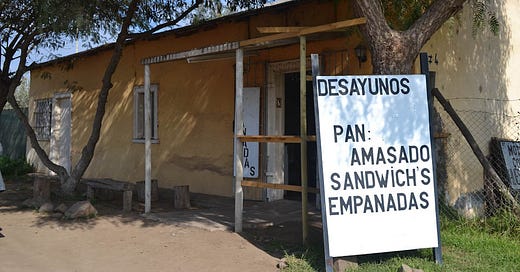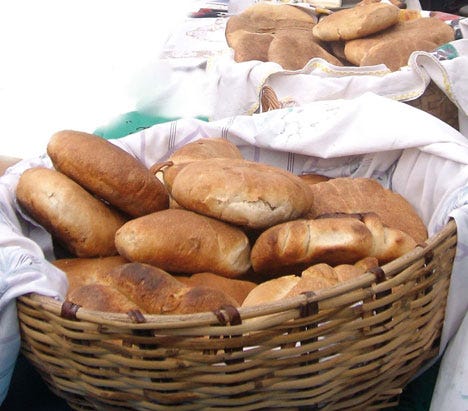One of the things that most distinguishes the Chileans from their Argentine neighbors and rivals is the centrality of bread in the Chilean diet versus the centrality of beef in the Argentine. Chileans, simply put, are carb-loaders extraordinaire, shoveling massive amounts of bread into their shopping bags and mouths every day of the week.
From close observation, the Chilean diet is mostly bread, empanadas, various corn-based dishes such as pastel de chocolo, more bread, sandwiches of spectacular inventiveness, and the odd hunk of pork, all washed down with a fizzy soda. There are variations to this basic theme, and a few noble Chilean dishes worthy of poetry, but that’s mostly it.
They also have some of the best seafood in the world, although Chileans eat surprisingly little of it, just as they drink surprisingly little of their own wine.
Carbohydrates, however, are the main theme in the diet, and a meal without bread is like a car without gas. It’s going no where, and no one is happy about it.
Bread is sold in most Chilean grocery stores by the kilo or by the piece from giant bins that are rapidly emptied by customers and just as rapidly refilled every fifteen minutes, all day long. At the end of the evening, when the ovens are turned off, you can guarantee that almost all the loaves will have been sold.
Chileans eat more bread (450 pounds per family per year) than anyone in the world except Germans. And unlike the Germans, who have rye and pumpernickel and whole wheat, 97% of Chilean bread is white bread. Thus, for the Chileans, bread is the staff, woolly socks, and hiking boots of life.
Chileans think nothing of stopping off for more bread on their way home from buying bread. This is because Chilean bread is very good when warm, and Chileans like to eat bread while walking, driving a car, riding on the metro, or flying in airplanes. (The Chileans being one of the few people, along with Americans, who think nothing of eating a Dagwood sandwich while walking down a public street. Any time being the right time for an ambulatory meal.)
In the countryside of Chile, along the public roads and in the parks, little old ladies sell fresh homemade pan amasado from baskets. Even alongside the main freeway, the Pan-American Highway, they’ll drag out a portable bread oven on wheels and put up a hand-lettered sign: “Pan Amasado”. Watch then, as Chilean drivers, who are the most responsible in Latin America, swerve over three lanes of on-coming traffic to get at that hot loaf of doughy goodness.
The correct translation of pan amasado is “kneaded bread”, and the words usually refer to a small, round, flatish loaf of white bread, called a hallulla, a sort of universal bun that’s often cooked in rural precincts in a wood-fired clay oven, un horno de leña. They’re made with lard (or vegetable shortening) and appear at most meals. Another reason pan amasado is a favorite is because it’s cheap. A hallulla sells for less than 15 cents, so you can really stuff it into your face without feeling guilty about wasting money.
I have a love-hate relationship with all bread, and pan amasado in particular. I love it when it’s good, like Chilean bread often is, but I hate what it does to me.
I have a “mild” wheat allergy that will sometimes cause me to swell up and stop breathing, especially if I eat something overly doughy, like thick pizza crust, or a second piece of pan amasado.
So far, I haven’t died from eating bread, but there’s always an outside chance, especially since the epi-pen I carry in my briefcase expired eight years ago. I suspect, given that I eat something wheat-based most days of the week, that I go around in a state of permanent semi-inflamation, always one sandwich away from disaster. During those few months I lived in Chile, I adopted a Chilean attitude toward disaster, which might be characterized as “it’s gonna happen, and if you survive it, you’ll live to see another one just like it.”
And this is why I love the Argentine diet, because the ultimate cure for my carb face, and my desire for kill-me-with-tastiness wheat, is beef, and lots of it.
When I lived in Argentina, I pretty much had one meal a day: a bife de chorizo—a steak—with a few french fries, a light salad and a half-bottle of red wine. While eating this diet I never felt the slightest desire for bread.
The funny thing is, it also never got old. I never thought to myself, “you know what, I had a giant steak yesterday, so I’ll have pasta today.” Never. Not once. And, to this day, I have on my cellphone pictures of bifes de chorizo I have known, tasty hunks of grass-fed beef cooked medium rare and served at the exactly right moment. Here’s one right here:
Ah yeh. That’s the stuff.
Follow me on Twitter, like me on Facebook, leave a comment and share this with your friends!








What do Argentines cook their fries in? In poison seed oils or in tallow as God intended as, as McDonald's used to do before 1985 and your great grandfather always did?
Are Chilean pigs raised industrially with seed oil meal as we now do? Or as God intended and your great grandfather did on food scraps and anything they can find and catch in the forest?
The body fat of our industrial pigs are 20-30% Polyunsaturated Fat just like the 500 pounder humans we can see in the fat acceptance movement.
Do you have the same problems with fermented bread?
Yum. But that's a hunka steak and more than a few fries!